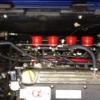
Cylinder Honing
#1

Posted 22 June 2013 - 08:40 PM
#2

Posted 22 June 2013 - 08:54 PM
#3

Posted 22 June 2013 - 08:59 PM
Honing should be done to a specific diameter leaving specific angle cross-hatch finish. This gives good combination of seal, oil retention and wear.
Using a home type tool will de-glaze but not hone, and the tools themselves are prone to wear off square regardless.
Whether you need the bores honed depends on specified diameter for the new pistons, the current bore wear / surface finish, and how they measure up.
#4

Posted 22 June 2013 - 09:10 PM
#5

Posted 22 June 2013 - 09:33 PM
#6

Posted 22 June 2013 - 10:01 PM
#7

Posted 23 June 2013 - 08:31 AM
Thanks Tom, that might be a good plan then. I'll check out the bay and see what I can find. Presumably if the bores are in good condition there's no problem with the new piston rings seating? Out of interest, why does having separate liners reduce the impact of the bore condition?
I would imagine (at a guess) it's cos they are made of steel rather than iron like the Z20LET.
BTW, I have a bore scope at home if you need to borrow one Ian.
#8

Posted 23 June 2013 - 08:37 AM
#9

Posted 23 June 2013 - 08:43 AM
When liners are installed into the block, are they an interference fit? If so, wouldn't that have a tendency to bend them out of shape a bit?
#10

Posted 23 June 2013 - 11:13 AM
From XU series PSA engine experience they are interference but don't require pressing in, just precisely machined so slide into the block.
Certainly on an XU PA engine they have a rubber o-ring seal that sits around the bottom of the liner and the block and when head is fitted they naturally seal by compression.
Good practise when removing an XU head, unless swapping out liners, is to then clamp the liners to the block before touching crank/rods/pistons to ensure you do not break the seal.
I would imagine the same practises exist on any wet linered engine.
#11

Posted 23 June 2013 - 11:42 AM
When liners are installed into the block, are they an interference fit? If so, wouldn't that have a tendency to bend them out of shape a bit?
'Factory' liners in the Z22SE and maby other ali engines these days are cast-in and not pressed in. The liners are in the block mold when the aluminium is poured into it, fixating them in the block permanently.
Pure ali blocks with nikasil coating or MMC alloyed blocks without any liners as such are much more rare.
Aftermarket liners/sleeves usually need to have the originals milled out, a sealing surface created at the bottom of the block and then the new liners pressed in with O-rings at the bottom.
These then need to be bored/machined as normal.. Darton is a big liner/sleeve manufacturer and has a lot of info on their site on the procedures:
http://www.darton-international.com/
Bye, Arno.
#12

Posted 23 June 2013 - 12:00 PM
Thanks for the offer Nev. I was thinking I may well take you up on this but then it occurred to me that as the head will be coming off anyway I should just be able to look at them and seeI would imagine (at a guess) it's cos they are made of steel rather than iron like the Z20LET. BTW, I have a bore scope at home if you need to borrow one Ian.
I guess if the bore liners are cast in I don't need to worry about this then?Good practise when removing an XU head, unless swapping out liners, is to then clamp the liners to the block before touching crank/rods/pistons to ensure you do not break the seal. I would imagine the same practises exist on any wet linered engine.
Edited by yaaan, 23 June 2013 - 12:01 PM.
#13

Posted 23 June 2013 - 01:57 PM
Nope, sounds like things have moved on since 198X!
#14

Posted 23 June 2013 - 02:57 PM
When liners are installed into the block, are they an interference fit? If so, wouldn't that have a tendency to bend them out of shape a bit?
'Factory' liners in the Z22SE and maby other ali engines these days are cast-in and not pressed in. The liners are in the block mold when the aluminium is poured into it, fixating them in the block permanently.
Pure ali blocks with nikasil coating or MMC alloyed blocks without any liners as such are much more rare.
Aftermarket liners/sleeves usually need to have the originals milled out, a sealing surface created at the bottom of the block and then the new liners pressed in with O-rings at the bottom.
These then need to be bored/machined as normal.. Darton is a big liner/sleeve manufacturer and has a lot of info on their site on the procedures:
http://www.darton-international.com/
Bye, Arno.
Nop, Z22SE liners/sleeves are simply pressed in. You can buy pre-honed replacement liners from GM (around $120/st) and there is an official toolset for in-situ replacement. ;-)
#15

Posted 23 June 2013 - 05:28 PM
#16

Posted 23 June 2013 - 06:37 PM
Well I have to get valve seats machined and fitted so I might as well spend the bit extra and get the bores done too. Just need to find a good machine shop nowWhen I rebuilt my engine I had the block honed for the new rings (still on original pistons). There were no hone markings left on the cylinders they were smooth. I can't see how the rings will bed-in correctly if yours are the same as mine. It didn't cost very much to get done.
#17

Posted 23 June 2013 - 09:13 PM
#18

Posted 24 June 2013 - 06:28 AM
Nop, Z22SE liners/sleeves are simply pressed in. You can buy pre-honed replacement liners from GM (around $120/st) and there is an official toolset for in-situ replacement. ;-)
Oops.. My bad, sorry.. ![]()
Very curious design decision though.. Cast-in liners are so common on many ali blocks these days.. But then again the Z22 (and it's siblings) do seem to have some more 'weirdness' here and there compared to many other engines. (the bizarrely high oil pressures it runs for one)
Bye, Arno.
#19

Posted 24 June 2013 - 07:10 AM
then again the Z22 (and it's siblings) do seem to have some more 'weirdness' here and there compared to many other engines.
Lotus designed = weirdness engineered in. ![]()
#20

Posted 24 June 2013 - 07:34 AM
Nop, Z22SE liners/sleeves are simply pressed in. You can buy pre-honed replacement liners from GM (around $120/st) and there is an official toolset for in-situ replacement. ;-)
Oops.. My bad, sorry..
Very curious design decision though.. Cast-in liners are so common on many ali blocks these days.. But then again the Z22 (and it's siblings) do seem to have some more 'weirdness' here and there compared to many other engines. (the bizarrely high oil pressures it runs for one)
Bye, Arno.
Well, GM turned to cast-in liners in the latest DI Turbo Ecotec engines... :-)
1 user(s) are reading this topic
0 members, 1 guests, 0 anonymous users



















